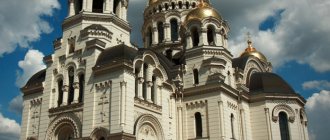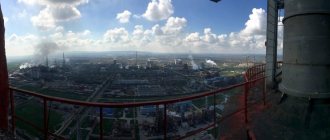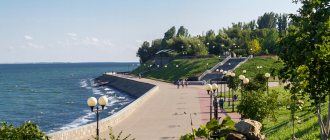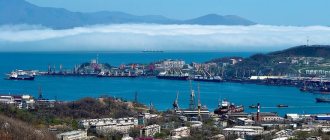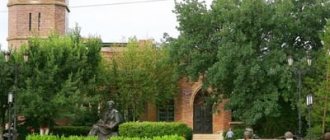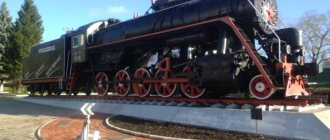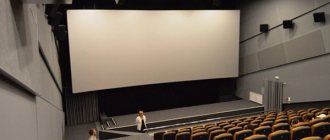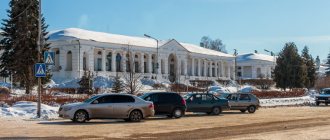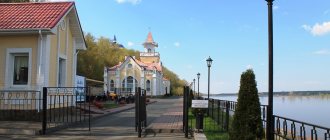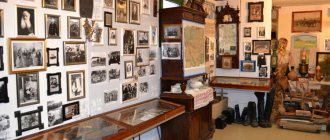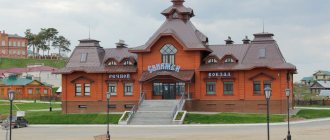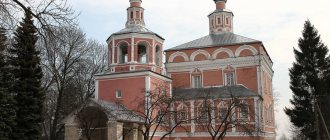Novocherkassk was founded in 1805 by Ataman Matvey Platov as the new capital of the Don Cossacks instead of the village of Cherkassk, which was regularly flooded by Don floods. This city retains its functions as the administrative center of the Don Cossacks today.
Did you know? At the congress of Cossack troops of Russia and Abroad in Moscow on July 18, 1993, the city of Novocherkassk acquired the status of the world capital of the Cossacks.
Patriarchal Ascension Cathedral Military Cossack Cathedral and Ermak Square
The main attraction is located in the city center - the Patriarchal Ascension Cathedral of the Cossack Military Cathedral, the third largest in Russia. The height of the cathedral is 74.6 m . The beginning of construction is the year the city was founded.
They designed and tried to build the cathedral twice. But due to weak soils and the presence of groundwater at shallow depths, the construction of such a massive structure could not be completed. Each time the cathedral collapsed; under the weight of its own mass it sank into the ground. The Cossacks decided to make the third and last attempt according to the project of A.A. Yashchenko. Construction was completed in 1904, and in 1905 the cathedral solemnly opened its massive carved doors in the presence of Nicholas II.
The cathedral is active, services are held in it, and the temple is beautifully decorated on church holidays. At night, the facades of the cathedral are illuminated by architectural lighting depicting scenes from the Bible. The main cross is decorated with rock crystal. In the basement of the cathedral, which has two tiers, baptisms are performed and the tomb is located. Marble sarcophagi store the remains of the founder of Novocherkassk M.I. Platov and other personalities significant for the history of the city. The interior of the cathedral is impressive: frescoes, paintings, and stained glass windows depict biblical scenes and pictures from the life of the Cossacks. Excellent acoustics can be enjoyed during festive services, which are accompanied by the singing of the church choir.
The cathedral is located on Ermak Square, paved with stone. There are also three monuments here. The first one, on the side of Ermak Avenue, is a monument to Ermak, the famous Don Cossack and conqueror of Siberia. It was opened in 1904 and has remained unchanged to this day.
On the other side of the cathedral in 1911. A monument to the hero of the Caucasian wars, Lieutenant General Ya.P. was opened, brought from St. Petersburg. Baklanov. His ashes are also kept in the cathedral crypt. The monument was heavily damaged during the First World War, but was completely restored in 1995.
On the side opposite the main entrance of the cathedral in 2005. a monument of reconciliation and harmony was erected, symbolizing the unity of the Cossacks and their reconciliation with their enemies.
Location: Ermaka Avenue.
Sights of the city of Novocherkassk with photos and descriptions
Novocherkassk is a very colorful city, home to more than two hundred historical and architectural monuments, nine of which have the status of objects of federal significance. Of course, most local attractions are closely connected with the history of the Don Cossacks.
Architecture of Novocherkassk
The old quarters of Novocherkassk with the architecture of the 19th century, made in the eclectic and modernist styles, amaze the imagination. The large space of the young city made it possible not to build densely, but to alternate it with green spaces, which made it possible to turn many buildings into original palaces and estates, which we can still see today.
- The Ataman Palace is one of the main attractions of the city. Until 1920, this building, made in the eclectic style, served as the residence of Cossack atamans and the highest persons of the state. Nowadays, this architectural monument is a branch of the Don Cossacks Museum.
- State Polytechnic University is a complex of buildings on Prosveshcheniya Street. The design of the buildings of this university was developed by the architect Roguysky in 1911, and their construction was completed only in the 1930s. Today these buildings have the status of architectural monuments.
- The Palace of Ceremonial Rites is a building erected at the end of the 19th century by the merchant Kiryunin. This beautiful building was called the “House of Happiness” until 1964. After restoration in the 1990s. The Wedding Palace was opened here.
- Kuznetsov Real School - this architectural object was built at the end of the 19th century on Atamanskaya Street. The building is made in the Byzantine style, its architect is V.I. Zuev. The corner façade was formerly decorated with a bell-shaped turret, which was demolished during the Soviet years. Today, city school No. 5 is located here.
Ataman Palace
A prominent place in the urban architecture of Novocherkassk is occupied by two triumphal arches, erected as a sign of the Cossacks’ merit in the War of 1812 and victory over Napoleon. They were built according to the design of the Moscow architect A. I. Rusk in 1817. These buildings greet tourists at the entrances to the city from the western and northeastern sides.
Churches and temples
In pre-revolutionary Novocherkassk, there were fourteen Orthodox churches, a Lutheran church and a Catholic church. Unfortunately, during the years of struggle against religion, several places of religious character were lost. Today, only eight churches have survived in which services are held.
- Ascension Cathedral is the central building of the architectural ensemble of Novocherkassk. This main Orthodox church of the Don Cossacks was founded at the founding of the city in 1805, but its construction took exactly 100 years. During construction, the building collapsed twice due to a weak foundation and haste, and was completed only the third time according to the project of Academician A. A. Yashchenko. The cathedral was closed by the Soviet authorities and reopened only in 1942 under the German occupation. For the 200th anniversary of the city, this building was restored and returned to its former majestic appearance.
- Michael the Archangel Church is one of the most beautiful buildings on Azov Square. It was erected in 1870 in the classic Russian style: with onion-shaped domes and barrel-shaped semi-columns.
- Assumption Church - this Catholic church was built by Polish architect Bronislaw Roguyski in 1906. During the Soviet period, the parish was closed, and the building was used as a canteen. Since 1994, the temple was returned to the Catholic community of Novocherkassk.
Ascension Cathedral
City museums
There are quite a lot of interesting museums in Novocherkassk that will introduce tourists to the history of the city and the Don Cossacks.
- The Museum of the History of the Don Cossacks was founded on November 22, 1899 through the efforts of “lovers of Don antiquity” in a building specially erected for this purpose. His collections were collected in all Cossack villages of the Don. During the Civil War, many exhibits were taken away, and they were returned only in 1947. Today, the museum complex's holdings include more than 115 thousand items, many of which have no analogues in the world.
- The Museum of the History of Viticulture and Winemaking was created in 1972 and introduces tourists to the history of the development of these crafts from antiquity to the present day. The collection includes copies of amphorae, silver lutheria and bowls, antique black-glazed utensils for drinking wine, and most importantly, varieties of local grapes. Of particular interest is the book of complaints and suggestions, in which you will see gratitude from foreign celebrities.
- The Museum of Memory of the Novocherkassk Tragedy of 1962 was opened with the support of the Soros Foundation in 2002. It tells the story of the sad events of government forces suppressing a strike by workers at an electric locomotive plant.
Museum of the History of the Don Cossacks
Museum of the History of Viticulture and Winemaking
Monuments
Statues and monuments are found everywhere in Novocherkassk. Conventionally, they can be divided into two large groups: the first is dedicated to the history of the Don Cossacks and prominent atamans, and the second is dedicated to the historical heritage of the USSR.
- Monument to Platov - dedicated to the ataman who founded Novocherkassk. It was created in 1853 by sculptor A.V. Tarasenko. In 1923, the sculpture was replaced by a monument to Lenin, and only 70 years later the famous founding father returned to his original place.
- The monument to Ermak is a unique sculpture dedicated to the famous Cossack chieftain who conquered Siberia. It was installed in 1904. Ermak Timofeevich is depicted standing at full height with a battle banner and the crown of Siberia in his hands. Today this monument is a cultural heritage site.
- The monument to the mass grave was erected at the burial site of the soldiers and officers who liberated Novocherkassk in 1943. The marble monument, on which the names of the victims are carved, was opened on the 50th anniversary of the Victory on the initiative of local authorities.
Monument to Platov
Other monuments of Novocherkassk:
- monument to Ataman Baklanov;
- bust of Suvorov;
- Monument to Reconciliation and Concord;
- Worship cross;
- monument to Yuri Gagarin;
- monument to aviators;
- memorial sign to the liquidators of the Chernobyl disaster;
- monument to Cossack horses.
Triumphal arches
On the western and northern sides of the city, by order of Platov, two identical arches were built in the style of late classicism. Since the city was located on a hill, from the north side you can clearly see the city’s microdistricts (villages) and the river. In addition, the arch is beautifully illuminated at night. The northern arch is located on the street. Herzen, and separates the central part of the city from the villages.
The second arch is located near the Azov market. From this place you can admire the Aksai hills and the villages adjacent to the city.
Ataman Palace
A small two-story building in the city center located at the intersection of Platovsky Avenue and Moskovskaya Street. Made in classicism style. On the façade there is an elegant balcony with cast lattice and open portals at the entrances. The palace was designed and built by I.O. Valprede in 1863.
The Ataman Palace was the residence of high-ranking officials, including the emperor during his visit to the city. Now it is a branch of the Museum of the Don Cossacks. On the first floor there is an exhibition of various museum exhibits, on the second floor a gallery of interiors is recreated with impressive beauty and richness of decoration: state rooms, the ataman’s office, a dining room, a large living room. In front of the palace there is a small park with a fountain.
Location: Dvortsovaya street - 5a.
History of creation
The idea of moving the capital was not immediately supported by the Cossacks, who did not want to move from their homes to the steppe 20 miles from the Don shores. In addition, the high ground for the new settlement was devoid of suitable drinking water due to the turbidity of the surrounding rivers. However, Emperor Alexander I supported Platov, the Don people began to build up the new city strictly according to plan and turned it into the center of the Cossack elite - military atamans and officers. Until the end of the 1860s, the “non-service” population was prohibited by the highest decree from buying land and real estate in Novocherkassk, as well as from building industrial enterprises closer than 20 miles from it.
The natural relief of the high tract Biryuchiy Kut was successfully used in the development plan of Novocherkassk. The main elements of the design of the city center were the following avenues: Ermakovsky, Platovsky and Baklanovsky, connected by vast squares with streets radiating from them, which emphasizes the expressiveness of the ensemble solution and does not allow chaotic construction. The combination of buildings of classical styles with elements of Cossack pomp characterizes the original architectural appearance of the city. The sights of Novocherkassk include 200 officially recognized historical and architectural monuments.
Alexander Garden and Mound of Glory
The Alexander Garden is located behind the Ataman Palace. It was founded by Ataman M.G. Khomutov in the early 1850s. Now it is a cozy city park. On the territory there are attractions for children, a cafe, a water park, and a small pond.
For the 35th anniversary of the Great Patriotic Victory, the Mound of Glory was built in the park on the hill, which served as a platform for exploring the surrounding area before the revolution. Four bayonets around the eternal flame symbolize four years of war. On the outer hemisphere of the monument, hero cities and data on the losses of city residents in the Great Patriotic War are listed.
Top 10 Novocherkassk attractions
The most important attraction in Novocherskassk is the Cathedral of the Ascension of the Lord. The Cossacks began its construction along with the foundation of the city, which was to become their capital.
In addition, there are many other interesting places in Novocherkassk:
- museums;
- parks;
- palaces;
- arches, etc.
Before traveling to Novocherkassk, it is better to plan in advance what to see and where to go. To make it easier for you to plan your route, I have prepared a list of the most popular attractions that you can visit in 1 day.
Cathedral of the Ascension
Construction of the Ascension Military Cathedral began in 1811, but the first visitors entered it only in 1905.
The domes of the temple are decorated with red gold, the main cross is decorated with rock crystal. Because of this, at any time of the day the cathedral seems to radiate light. In Russia, the temple is considered the third highest dome - they are located 74.6 m above the ground.
The floor of the cathedral is covered with marble, which in the past was delivered from Italy and France. The temple clock and interior have been preserved in the same form as they were originally.
Nizhny Pokrovsky Church
The tomb, in which there are marble sarcophagi, is called the Lower Church of the Intercession of the Blessed Virgin Mary. Matvey Platov, the founder of the city, is buried here. Vasily Orlov-Denisov and Pyotr Baklanov - heroes of the war of 1812 - also lie in this tomb, as do the remains of Archbishop John.
You will also like: Where to go by car in the Lipetsk region
Baptist Church
In the 18th century Many Germans began to come to Russia for permanent residence. They needed a religious building, which was erected.
The Lutheran Church is different from Christian churches. According to the beliefs of Lutherans, not only services were held in the building - concerts were also held here. Since the 70s XX century the church was left without parishioners. But 20 years later, the Baptist community of Evangelical Christians restored the building. Services are now held here.
Ataman Palace
After its construction in 1863, the Palace of Atamans of the Don Army was used for its intended purpose. From here the management of the Cossack region was carried out. In 1918, Ataman Kaledin committed suicide in the palace.
Now the building houses a museum. All rooms of the palace have been reconstructed. The collections and historical documents placed will help you learn not only about the atamans who served the Fatherland in these parts, but also about their life.
Museum of Viticulture and Winemaking
The place was visited by Thor Heyerdahl, Sienkiewicz, cosmonaut Leonov and Marshal of the Soviet Union Grechko. The history of local winemaking began during the Khazar Kaganate.
Pushkin praised the wines produced on the Don in his works. Local craftsmen have received awards from our country and won international competitions.
Triumphal arches
The Don Cossacks accomplished many feats during the Patriotic War of 1812. Alexander I, in order to personally thank the heroes, went to their capital - Novocherkassk. He could only enter the city from both the northern and western sides, so Ataman Platov decided to erect 2 triumphal arches.
In the USSR, these monuments were considered of no interest to anyone, but now they have been completely restored according to the original drawings. Now they decorate the capital of the Don Cossacks. Everyone who comes here loves to take photographs.
Memorial "Mound of Glory"
In 1980, a memorial was solemnly opened in Alexander Park in memory of all who fought for our Motherland during the Great Patriotic War. The monument reminds that no one should forget the feat of the Soviet people and individual heroes.
Grove "Red Spring"
The history of this beautiful corner of nature began at the end of the 19th century. Then the first trees appeared here. They were landed by order of Ataman Krasnokutsky. Under Soviet rule, the place began to be called “Red Spring”.
You will also like: What to see in St. Petersburg in 3 days
The grove is located near Novocherkassk in the west. Nowadays it has been given the status of a natural monument. Citizens spend their free time here on weekends. On the territory of the grove there are 2 sports grounds and a play area for children.
Alexander Garden
In 1850, Ataman Khomutov decided to build a park on the territory of Gostinodvorskaya Square. In the Alexander Garden there is a mound from which a beautiful view of the surrounding area opens.
Emperor Alexander III, after whom the garden is named, loved to come here and visit the observation deck. Moreover, the Ataman Palace, where Russian royalty stayed, is located nearby. You can walk here and have a photo shoot today.
Park "Cossack"
Initially the park was called “Pervomaisky”. It was built by townspeople working on subbotniks. The park was opened in 1970 on the May holidays in the hope that it would become a favorite place for children.
Now the name has been changed to “Cossack”. It has the largest number of interesting attractions in the city and is crowded not only on weekends, but also on weekdays.
Museum of the History of the Don Cossacks
It is one of the oldest in the southern part of Russia and large in the number of relics and exhibits (about 115 thousand) related to the life, service and traditions of the Cossacks. It was formed in 1899 at the expense of public donations and the Cossack treasury. The museum displays a collection of paintings by famous Russian artists.
The scientific library contains about 15 thousand rare copies. In addition to the Ataman Palace, the following branches operate at the museum: the house-museum of the artist I.I. Krylov, museum of the poet V.G. Kalmykov, house-museum of the artist M.B. Grekova.
Location: Atamanskaya street - 38.
Cossack Drama Theater named after. V.F. Komissarzhevskaya
The theater began operating in the city in 1825. During its existence, it moved many times, and there was a fire in the theater three times. Since 1965, Atamanskaya Street has been the permanent location of the theater.
The great Russian actress Vera Komissarzhevskaya began her career on the stage of the drama theater in 1893. The theater received the additional name “Cossack” in 1991, during the active revival of Cossack culture.
Location: Platovsky Avenue - 72.
Where to go in Novocherkassk
Tired of sightseeing in Novocherkassk, you can diversify your active leisure time by visiting:
- water park "Oasis" in the historical center of the city on the territory of the Alexander Garden, accommodates 500 people;
- Pride family entertainment center with a climbing wall of varying difficulty and children's playrooms;
- Higher Level paintball club with the latest equipment, various fields and comfortable recreation areas;
- amusement park Regatta;
- Tolokonnikov's private Ginkgo Park in an abandoned clay quarry;
- a variety of cafes, restaurants and karaoke clubs.
Monument to Franz Pavlovich de Volan
The opening of the monument took place in 2003. Franz Pavlovich de Volan - military engineer, lieutenant general, according to whose design the city was built. It is because of the similar layout of the two cities that Novocherkassk is called “little Paris”.
The “beams” of the main streets extend from Ermak Square: Platovsky and Ermak Avenues, Krasny Descent. Ermak Avenue abuts Trinity Square, from which Baklanovsky Avenue, Herzen Descent, Troitskaya Street, and Moskovskaya Street also radiate.
Location: Platovsky Avenue.
Platovsky Avenue.
Platovsky Prospekt is a beautiful street in the shade of trees in the center of Novocherkassk, 3200 meters long. It is surrounded by ancient elegant houses, museums, and temples.
The avenue on which the monument is located is named in honor of Ataman Matvey Ivanovich Platov. He took part in all the wars of the Russian Empire in the 17th – 19th centuries. It was he who founded the city of Novocherkassk and moved the capital of the Don Cossack Army there.
Previously, the capital was in Cherkassk (now it is the village of Starocherkasskaya), but not only was it often flooded, but the fire did not spare its houses. But the Cossacks did not want to leave their homes, because of this, the construction of Novocherkassk proceeded very slowly.
Monument to L. Fricke.
Walking along the avenue, we will see a monument to the academician and painter Login Khristianovich Fricke (1820-1893). It stands opposite the building where the artist lived. Fricke traveled a lot in Europe, was in Holland, Germany, Italy. But then he moved to live in Russia and often visited Moscow. In the 1850s traveled to Crimea, where he created many landscapes. He also loved the Don region very much and painted many paintings depicting its beauty.
His famous works are: “View of Count A.H. at Cape Fall.” Benckendorf near Revel", 1837. And "Landscape with Figures", 1845.
“View of Count A.H. at Cape Fall. Benckendorf near Revel"
"Landscape with Figures"
He lived and worked in this house from 1861 to 1893. L.H. Fricke. Also in this house, honorary citizen of Novocherkassk, Lieutenant General of the Ministry of Internal Affairs of Russia A.V. Ponidelko was born on November 8, 1944.
Museum of the History of the Don Cossacks.
Atamanskaya street, 38.
The museum contains paintings by famous artists, the world’s only collection of Cossack banners, horsetails and regimental standards of the Don Cossacks, as well as memorial items of the city’s founder, Matvey Ivanovich Platov.
Monument to the Cossack.
Monument to Franz Pavlovich de Volan.
Franz de Woland was the first architect of Novocherkassk, as well as Voznesensk, Odessa, etc., the builder of the first cast iron bridge in St. Petersburg, the first engineer at the head of the Department of Railways.
Another monument to Matvey Ivanovich Platov near the Ataman Palace.
Monuments to M.I. Platov
In Novocherkassk there are two monuments dedicated to M.I. Platov. One is installed opposite the main entrance to the cathedral on Platov Avenue. The bronze monument, where the ataman is on horseback, was opened on the 250th anniversary of his birth, in 2003.
The second monument, where M.I. Platov is represented standing on a pedestal, which is the first sculptural monument in the city. Opened in 1853, during Soviet times it was dismantled and melted down. The reconstruction of the monument in the same place took place in 1993. The monument is located in front of the Ataman Palace.
Location: Platovsky Avenue.
Monuments of Cathedral Square
Ermak Square is also called Cathedral Square by local residents. It is surrounded by several significant sights of the city of Novocherkassk:
- Monument to Ermak - with the crown of Siberia and a banner in his hands, erected in 1804; authors M. Mikeshin, V. Beklemishev.
- The monument to Baklanov - in honor of the lieutenant general, the “thunderstorm of the Caucasus”, an outstanding military ataman, was erected according to Gavrilov’s design in 1911 in the form of a granite rock with a battle banner, a Cossack cloak, a hat and a hero’s saber.
- The Monument of Reconciliation and Harmony is a monument to modern history (2005) by A. Sknarin and I. Zhukov in the form of memorial plates with the names of Cossack regiments and a woman with a boy soldier in the center, symbolizing the unification of Cossacks with different political views.
- The Platov Monument is one of two monuments to the founder of the city; The equestrian statue was erected for the 250th anniversary of the birth of the great leader of the Don Army, authors A. Sknarin, I. Zhukov.
South Russian State Polytechnic University
The abundance of educational institutions in Novocherkassk has given it the name “city of students.” The Polytechnic University is the first and main educational institution in the south of Russia. In 2022, the university will mark 110 years since its founding. This is a magnificent ensemble of educational buildings in the neoclassical style.
The buildings are located along the perimeter so that they form a courtyard, park and stadium inside. In the main building of the university, which is located on Prosveshcheniya Street, there is an indoor courtyard - a large space inside the building with a transparent ceiling. Exhibitions and special events take place here.
Location: Prosveshcheniya Street - 132.
What to see in Novocherkassk in one day
Tourists need a lot of time to get to know all the sights of Novocherkassk in detail. But if you are in this city for just one day, then for a walking tour you need to use approximately the following route:
- Start your tour from Ermak Square in the center of Novocherkassk. Here you will see the main Cossack temple - Ascension Cathedral .
- Opposite the cathedral on Platovsky Avenue you can see a monument to the founder of the city N.I. Platov .
- The next point of your journey around the city is the Don Cossacks Museum located on Atamanskaya Street.
- After getting acquainted with the exhibits, go to the next attraction - Ataman Palace , which is located just a 15-minute walk from the museum, on Dvortsovaya Street.
- the Alexander Garden located next to it , go to the city's triumphal arch on Platovsky Prospekt.
- The best option to end the excursion would be a walk in Tolokonnikova Park , where you can relax and enjoy exotic plants.
Important! Most of the proposed route runs along Platovsky Prospekt. On this street, in addition to the places mentioned, you can see many other attractions.
Michael the Archangel Church
Novocherkassk has always been and is a stronghold of the Russian Orthodox faith. This is evidenced by a large number of temples and churches. Michael the Archangel Church, built in 1870, is located on Azov Square, not far from the western triumphal arch. Made in Russian style with onion domes.
Location: Platovsky Avenue - 79a.
Alexander Nevsky Church
It is located right behind the Alexander Garden. It was founded in 1851 according to the decree of Nicholas I, in memory of the appointment of his son, Alexander, as the august chieftain. The church was built in 1896 in the Russian-Byzantine style, the stone bell tower was added in 1902. The church was called the ataman church, since it was often visited by military atamans who lived next to the temple.
Location: Alexandrovskaya street - 78.
Church of St. George the Victorious.
st. Mayakovsky, 30.
Let's start the route from the Church of St. George the Victorious. We stayed in a house just opposite it. Find tips on how to rent a house here .
The road to the temple is very rough, and it is located among private houses.
Church of St. George the Victorious.
The style is Russian with Baroque elements. The church was built in memory of saving the life of Alexander III during the crash of the royal train on October 17, 1888. Consecrated in 1898
The temple was built exclusively from private donations. In 1891, two people living in different parts of the city began to encourage people to build a church on Kolodeznaya Square. To properly supervise the construction, future parishioners elected 10 trustees. The board of trustees set to work with only 3 rubles donated by one priest.
But the temple received many donors, and Feodosia Kashcheeva gave 5,000 rubles to the trustees and promised to provide assistance. According to local legends, she rests on the temple grounds.
Archpriest Alexander Popov became the first rector of the temple. A parish school was built under him.
Temple decoration:
Temple of Constantine and Helena
Initially it was wooden, in 1906 it was decided to build a stone temple in the Old Russian style. Construction took three years, and in 1909 the church was consecrated. In the 1990s, the crosses and domes in the church were gilded. The choir sings during services. The church is located on Sennaya Square, which offers a beautiful view of the city's microdistricts.
Location: Sennaya Square.
